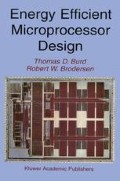Abstract
As seen in previous chapters, use of the appropriate voltage for the performance required is one of the most powerful techniques for improving energy efficiency. This can be either done statically by choosing the single most appropriate voltage for the throughput required or dynamically by using information obtained by the operating system and applications. This chapter introduces switching regulators which allow translations of DC voltages with efficiencies of over 90%. Design equations and closed-form expressions for losses are presented for the three basic low-voltage CMOS switching regulator topologies — buck, boost, and buck-boost — controlled via pulse-width or pulse-frequency modulation. This then will be followed for the enhancements to the basic design that are required for efficient dynamic voltage regulation.
Access this chapter
Tax calculation will be finalised at checkout
Purchases are for personal use only
Preview
Unable to display preview. Download preview PDF.
References
J. Kassakian, M. Schlecht, and G. Verghese, Principles of Power Electronics, Addison-Wesley, 1991.
A. Stratakos, S. Sanders, and R.W. Brodersen, “A Low-voltage CMOS DC-DC Converter for Portable Battery-operated Systems”, Proceedings of the Twenty-Fifth IEEE Power Electronics Specialist Conference,June 1994, pp. 619–626.
A. Stratakos, High-Efficiency,Low-Voltage DC-DC Conversion for Portable Applications, Ph.D. Thesis, University of California, Berkeley, 1998.
D. Aebischer, et. al., “A 2.1-MHz Crystal Oscillator Time Base with a Current Consumption under 500nA”, IEEE Journal of Solid State Circuits, Vol. 32, No. 7, Jul. 1997, pp. 999–1005.
J. Montanaro, et. al., “A 160-MHz 32-b 0.5-W CMOS RISC Microprocessor”, IEEE Journal of Solid State Circuits, Vol. 31, No. 11, Nov. 1996, pp. 1703–14.
Author information
Authors and Affiliations
Rights and permissions
Copyright information
© 2002 Springer Science+Business Media New York
About this chapter
Cite this chapter
Burd, T.D., Brodersen, R.W. (2002). DC-DC Voltage Conversion. In: Energy Efficient Microprocessor Design. Springer, Boston, MA. https://doi.org/10.1007/978-1-4615-0875-5_7
Download citation
DOI: https://doi.org/10.1007/978-1-4615-0875-5_7
Publisher Name: Springer, Boston, MA
Print ISBN: 978-1-4613-5282-2
Online ISBN: 978-1-4615-0875-5
eBook Packages: Springer Book Archive

